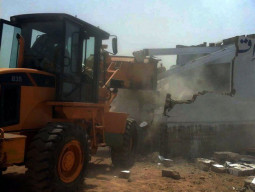
But three and a half decades later, at least 112 allottees are still trying to get possession of their properties that were due to be handed over back then. “We always hear about the builders’ mafia encroaching upon properties and illegally selling land but in my experience, government authorities are equally corrupt when it comes to the misappropriation of residential plots,” said Aley Abid, one of the affected allottees of Shah Latif Town, while speaking to The Express Tribune.
The KDA initiated the project, which spread over 500 acres with roughly 50,000 plots of varying sizes, and later transferred it to the Malir Development Authority after the former became defunct in 1993. The KDA, however, made many ‘dual allotments’ in 1992, which included Abid’s three residential plots that he purchased by paying full occupancy value in the early 1980s. His decades-long struggle to get possession of his property has remained unsuccessful so far.
Not only did he not receive possession orders, he says, but the defunct KDA allotted his designated plots to other people as ‘alternate plots’ in 1992.
In response to Abid’s complaint that was registered in 2012 with the Secretariat of the Sindh Ombudsman — the independent office set up to address complaints of ‘maladministration’ by agencies of the provincial government — the MDA admitted that the land had been transferred to people other than their rightful owners.
Financial loss
“The complainant having been deprived of the residential plots for almost three decades has already suffered financial loss and mental agony not due to his own fault but because of the inefficiency of the officers concerned, which amounts to gross maladministration on their part,” the Sindh ombudsman wrote in his decision on the case last February.
Considering the time value of money, the estimated financial loss to the complainant is indeed significant. At the price of Rs50 per square yards, a residential plot of 80 square yards cost Rs4,000 back then.
And according to real estate agents, the going rate for residential plots in Shah Latif Town is around Rs4,000 per square yard now. This translates to a price tag of Rs320,000 for an 80-square-yard residential plot in the locality today.
In other words, the value of investment would have increased at the rate of 14.6% every year for the last 32 years had Abid received possession of his property in 1982 — the year he paid the fourth and final instalment.
The Sindh ombudsman, in his decision, directed the director-general of MDA to allot alternate plots of the same size to the complainant in lieu of his original plots ‘without any further loss of time’. He added that the MDA must comply with the decision within 60 days.
In addition, the ombudsman asked the authorities to conduct an inquiry, fix responsibility and take disciplinary action against officers found negligent in performing their duties and re-allocating the complainant’s plots. “Compliance should be reported to me within 60 days,” he wrote in his decision dated February 6, 2014.
However, neither the allotment of alternate plots to the complainant nor any enquiry into the illegal transfer of property has taken place following the ombudsman’s decision.
Attempts to contact MDA director-general Sohail Khan remained futile for many days because his staff said he was not present in his office.
In their correspondence with the ombudsman’s secretariat, MDA officials have claimed repeatedly that the allotment of alternate plots is currently not possible because it was banned by the Sindh government in 1995.
Abid says the provincial government should either allot him alternate plots immediately or pay him back his principal along with the interest that he would have earned otherwise on a typical National Savings Scheme since 1982. “It is the government’s direct responsibility to address my case, as the illegality was committed by one of its own agencies,” he said.
Published in The Express Tribune, January 18th, 2015.


1719660634-1/BeFunky-collage-nicole-(1)1719660634-1-165x106.webp)

1732276540-0/kim-(10)1732276540-0-165x106.webp)












COMMENTS
Comments are moderated and generally will be posted if they are on-topic and not abusive.
For more information, please see our Comments FAQ